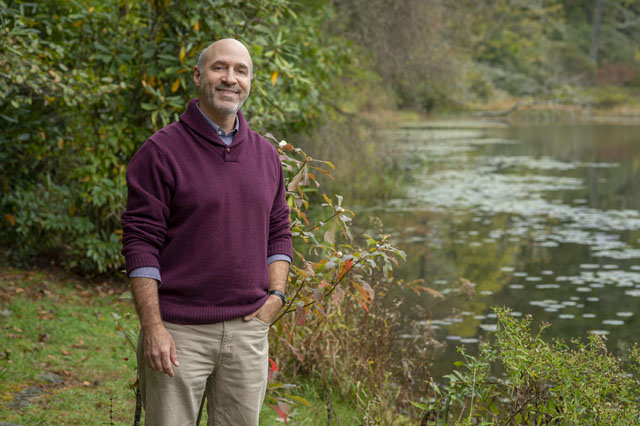Chief on Duty
04 Oct 2023
Randy Dillard’s Deep-Rooted Leadership in Jackson County
Story by KRISTIN E. LANDFIELD
Photos by CAROLE SHEPARDSON

In 1979 a young Randy Dillard was voted in as a firefighter to the Cashiers Glenville Volunteer Fire Department. It was February 12th, and he'd been set and ready to go since his 18th birthday on January 4th of that year—the moment he became eligible. This fact is a clue as to how Chief Randy Dillard feels about his 44-year commitment to the department all these years later. Those 6 weeks of waiting mattered to 18-year-old Randy, and it's clear when listening that each six weeks since has also mattered to him.
In Cashiers, Chief Dillard is someone who matters. His reach has extended far beyond the walls of the fire station or the cabs of its well-equipped trucks. This is because to Dillard, other people matter; these mountains, this community, the welfare of others: they all matter. He treats each call, each fire, each accident, each knock on the station door, and each meal as an opportunity to connect with someone personally. Such generosity of spirit can be rare among successful leaders. In his time as chief, Dillard’s department has grown steadily, but the inevitable swell in demands and complexities has not clouded his sense of care for individuals—neighbors and visitors alike.
Dillard is an embodied history of the last half-century of life in Cashiers, NC. It is hard to imagine anyone becoming more integrated in a community, in both practice and personality. Indeed, having a conversation with Chief Dillard can be like going on a little adventure—a local one—led by someone who has likely collected a story or a memory to match almost any topic. A conversation may begin with a few questions about his time as the longstanding leader of a busy and growing fire department, but Chief Dillard’s life is so woven into the fabric of Jackson County that his answer could land on almost any square foot of this plateau. Literally, in his 44 years as a firefighter, he has covered one of the largest fire districts in the state—135 square miles. This district includes incredibly rugged terrain with limited access to water or additional sources of help. Certainly, he has faced untold challenges throughout his time firefighting, but these mountains are as much a part of him as the warm, welcoming tone of his voice.
Dillard essentially grew up in the firehouse. His father, Thomas Franklin Dillard, was a founding member in 1967. These men cleared the land by hand and thus begun what is now an ambitious seven station district. The members all signed a loan for $2,500 to buy a 1946 Seagrave fire truck from Baltimore County, MD. Over the years, as technology and vehicles have expanded, the original firetruck has become a beloved symbol of the department’s role in the community. Having been restored and on display, along with other memorabilia at the station, the truck has become a fun landmark to visit. The Seagrave may carry a bride to her wedding or take children on rides as many as five times a day. Chief Dillard remarked how much he appreciates that people want to come see them at the fire station. “Visitors to the station aren’t an interruption—they’re an honor.” The truck’s shiny façade, however, belies the incalculable hard work and tragic events it has attended for over five decades in Jackson County. I have to believe that some of the joy they derive in community outreach acts as a tonic to assuage the tragedy and danger intrinsic to their jobs.
Since those early days, the department has steadily expanded as time and resources permit. As with most volunteer fire departments, limited funding dictates limits to growth. Fundraising has been a big piece of the story, and still is. However, when the district fire tax was implemented nine years ago, the Cashiers Glenville Volunteer Fire Department grew in stability, wages and benefits they could offer. There are now 11 paid full-time members who rotate on three-person shifts on 48-hour cycles, along with Chief Dillard. They have 23 volunteers, which is down since times past. In addition, the department employs 16 part-time fire fighters. It is obvious that the chief takes well-won pride in what these developments can offer. He sees it as both his duty and his concern to build up young firefighters, thus edifying a next generation of local heroes. Being devoted to family himself, it’s important to Dillard to create positions that sustain firefighters and their families, thereby maintaining a local legacy.
Chief Dillard’s geniality is punctuated by his pride in tradition and in careful stewardship of those who serve and those he serves. When I spoke to Randy, he had just returned from an event at Wade Hampton that provides grants to local organizations. He quickly mentioned “all the good that events like that do for people.” In 2015 this same event awarded Chief Dillard a leadership award, along with $5000 for the department. For much of our conversation, while I asked about him, he instead shared about everyone else: how generous people have been, how local businesses champion them, and how he has been there as chief for as long as he has only because the firemen are so exceptional: “good folks interested in serving.” Without them, he asserted, he would not be who he is. True enough, but when I hear those words, I hear that Randy Dillard is the common denominator. It’s human nature—people are supportive when they feel supported. These men and women know they have their chief’s support. Until the district fire tax, when he was employed as chief by the Board of Directors, his position was decided by annual vote of the firefighters themselves. Since 1985, his team continues to choose him as their leader.
In our conversation, the chief was clear: wildfire poses the prime threat to our region. This past spring, the number of wildfires in the area was significantly higher than in years past. With the area’s rapid expansion, the department expanded accordingly. However, the ever-growing interface between the built environment and wild spaces means that the mountain landscape is simply more vulnerable to fire initiation and less resilient to natural fire patterns, so both human and wildlife habitats face greater threat. The causes for this are complex, related in part to fire suppression practices required for habitation, agriculture, roads, etc. Continued development interrupts natural systems. Chief Dillard and his team, in conjunction with allied organizations, seek to rise to such challenges. In the Southern Appalachians, most fire is human initiated—escaped burn piles, arson or carelessness at campsites. Consequently, education is at the heart of what they do, intending to inhibit such fires before they begin. Fighting fire and accidents are best fought upstream. It is clear Chief Dillard enjoys sharing what he has learned over a lifetime and a treat to hear his enthusiasm toward collaboration with people from all walks of life.
With Chief Dillard’s gracious optimism and earnest pride, one could easily forget that what they do is fight fires—fast moving, unpredictable and molten events that put them directly in harm’s way and witness to tragic moments in their neighbor’s lives. Across the decades, he has organized his life around the rigorous schedule of a volunteer fire department, ensuring that each shift is covered and that each home and business is as protected as possible. Randy Dillard attends this community in its most precious moments, when people are most vulnerable, as well as when they are most celebratory. His devotion and strong leadership, tempered by a laudable dose of humility, are key ingredients to his success in this region he loves. To meet Randy Dillard is to recognize someone whose big heart is behind the many small acts that make up a full life.
To Send a Contribution, either stop by the department or send to the following address:
Cashiers Glenville Volunteer Fire Department
PO Box 1978
Cashiers, NC 28717-1978













